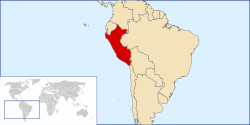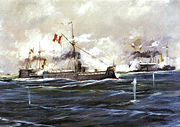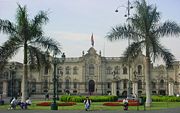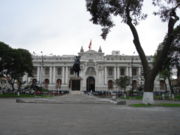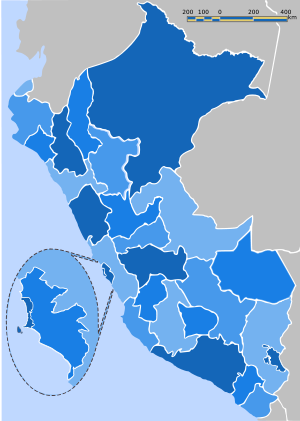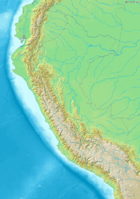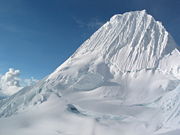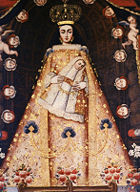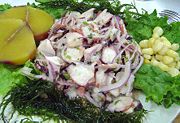Peru
2008/9 Schools Wikipedia Selection. Related subjects: Americas; Countries
| República del Perú (Spanish) Republic of Peru
|
||||||
|---|---|---|---|---|---|---|
|
||||||
| Anthem: " Somos libres, seámoslo siempre" (Spanish) "We are free, may we always be so" |
||||||
|
|
||||||
| Capital (and largest city) |
Lima |
|||||
| Official languages | Spanish1 | |||||
| Demonym | Peruvian | |||||
| Government | Presidential republic | |||||
| - | President | Alan García Pérez | ||||
| - | Vice President | Luis Giampietri Rojas | ||||
| - | Prime Minister | Jorge Del Castillo | ||||
| - | President of Congress | Luis Gonzales Posada | ||||
| Independence | from Spain | |||||
| - | Declared | July 28, 1821 | ||||
| - | Recognized | December 9, 1824 | ||||
| Area | ||||||
| - | Total | 1,285,220 km² ( 20th) 496,222 sq mi |
||||
| - | Water (%) | 8.80 | ||||
| Population | ||||||
| - | July 2007 estimate | 28,674,757 ( 41st) | ||||
| - | 2005 census | 27,219,266 | ||||
| - | Density | 22/km² ( 183rd) 57/sq mi |
||||
| GDP ( PPP) | 2007 estimate | |||||
| - | Total | $207.985 billion ( 51st) | ||||
| - | Per capita | $7,410 ( 79th) | ||||
| GDP (nominal) | 2007 estimate | |||||
| - | Total | $101.504 billion ( 55th) | ||||
| - | Per capita | $3,616 ( 87th) | ||||
| Gini (2002) | 54.6 (high) | |||||
| HDI (2005) | ▲0.773 (medium) ( 87th) | |||||
| Currency | Nuevo Sol ( PEN) |
|||||
| Time zone | PET ( UTC-5) | |||||
| Internet TLD | .pe | |||||
| Calling code | +51 | |||||
| 1 | Quechua, Aymara and other indigenous languages are co-official in the areas where they are predominant. | |||||
Peru (Spanish: Perú, Quechua: Piruw, Aymara: Piruw), officially the Republic of Peru (Spanish: República del Perú ( help· info), IPA: [re'pu.βli.ka del pe'ɾu]), is a country in western South America. It is bordered on the north by Ecuador and Colombia, on the east by Brazil, on the southeast by Bolivia, on the south by Chile, and on the west by the Pacific Ocean.
Peruvian territory was home to the Norte Chico civilization, one of the oldest in the world, and to the Inca Empire, the largest state in Pre-Columbian America. The Spanish Empire conquered the region in the 16th century and established a Viceroyalty, which included most of its South American colonies. After achieving independence in 1821, Peru has undergone periods of political unrest and fiscal crisis as well as periods of stability and economic upswing.
Peru is a representative democratic republic divided into 25 regions. Its geography varies from the arid plains of the Pacific coast to the peaks of the Andes mountains and the tropical forests of the Amazon Basin. It is a developing country with a medium Human Development Index score and a poverty level around 45%. Its main economic activities include agriculture, fishing, mining, and manufacturing of products such as textiles.
The Peruvian population, estimated at 28 million, is multiethnic, including Amerindians, Europeans, Africans and Asians. The main spoken language is Spanish, although a significant number of Peruvians speak Quechua and other native languages. This mixture of cultural traditions has resulted in a wide diversity of expressions in fields such as art, cuisine, literature, and music.
Etymology
The word Peru is derived from Birú, the name of a local ruler who lived near the Bay of San Miguel, Panama, in the early 16th century. When his possessions were visited by Spanish explorers in 1522, they were the southernmost part of the New World yet known to Europeans. Thus, when Francisco Pizarro explored the regions farther south, they came to be designated Birú or Peru. The Spanish Crown gave the name legal status with the 1529 Capitulación de Toledo, which designated the newly encountered Inca Empire as the province of Peru. Under Spanish rule, the country adopted the denomination Viceroyalty of Peru, which became Republic of Peru after independence.
History
The earliest evidence of human presence in Peruvian territory has been dated to approximately 11,000 years BCE. The oldest known complex society in Peru, the Norte Chico civilization, flourished along the coast of the Pacific Ocean between 3000 and 1800 BCE. These early developments were followed by archaeological cultures such as Chavin, Paracas, Mochica, Nazca, Wari, and Chimu. In the 15th century, the Incas emerged as a powerful state which, in the span of a century, formed the largest empire in pre-Columbian America. Andean societies were based on agriculture, using techniques such as irrigation and terracing; camelid husbandry and fishing were also important. Organization relied on reciprocity and redistribution because these societies had no notion of market or money.
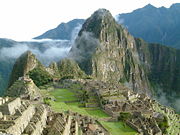
In 1532, a group of conquistadors led by Francisco Pizarro defeated Inca Emperor Atahualpa and imposed Spanish rule. Ten years later, the Spanish Crown established the Viceroyalty of Peru, which included most of its South American colonies. Viceroy Francisco de Toledo reorganized the country in the 1570s with silver mining as its main economic activity and Indian forced labor as its primary workforce. Peruvian bullion provided revenue for the Spanish Crown and fueled a complex trade network that extended as far as Europe and the Philippines. However, by the 18th century, declining silver production and economic diversification greatly diminished royal income. In response, the Crown enacted the Bourbon Reforms, a series of edicts that increased taxes and partitioned the Viceroyalty of Peru. The new laws provoked Túpac Amaru II's rebellion and other revolts, all of which were defeated.
In the early 19th century, while most of South America was swept by wars of independence, Peru remained a royalist stronghold. As the elite hesitated between emancipation and loyalty to the Spanish Monarchy, independence was achieved only after the military campaigns of José de San Martín and Simón Bolívar. During the early years of the Republic, endemic struggles for power between military leaders caused political instability. National identity was forged during this period, as Bolivarian projects for a Latin American Confederation foundered and a union with Bolivia proved ephemeral. Between the 1840s and 1860s, Peru enjoyed stability under the presidency of Ramón Castilla due to increased state revenues from guano exports. However, by the 1870s, these resources had been squandered, the country was heavily indebted, and political in-fighting was again on the rise.
Peru was defeated by Chile in the 1879–1883 War of the Pacific, losing the provinces of Arica and Tarapacá in the treaties of Ancón and Lima. Internal struggles after the war were followed by a period of stability under the Civilista Party, which lasted until the onset of the authoritarian regime of Augusto B. Leguía. The Great Depression caused the downfall of Leguía, renewed political turmoil, and the emergence of the American Popular Revolutionary Alliance (APRA). The rivalry between this organization and a coalition of the elite and the military defined Peruvian politics for the following three decades.
In 1968, the Armed Forces, led by General Juan Velasco Alvarado, staged a coup against president Fernando Belaunde. The new regime undertook radical reforms aimed at fostering development but failed to gain widespread support. In 1975, Velasco was forcefully replaced as president by General Francisco Morales Bermúdez, who paralyzed reforms and oversaw the reestablishment of democracy. During the 1980s, Peru faced a considerable external debt, ever-growing inflation, a surge in drug trafficking, and massive political violence. Under the presidency of Alberto Fujimori (1990–2000), the country started to recover; however, accusations of authoritarianism, corruption, and human rights violations forced his resignation after the controversial 2000 elections. Since the end of the Fujimori regime, Peru has tried to fight corruption while sustaining economic growth; the current president is Alan García.
Government
Peru is a presidential representative democratic republic with a multi-party system. Under the current constitution, the President is the head of state and government; he or she is elected for five years and may not immediately be re-elected. The President designates the Prime Minister and, with his advice, the rest of the Council of Ministers. There is a unicameral Congress with 120 members elected for a five-year term. Bills may be proposed by either the executive or the legislative branch; they become law after being passed by Congress and promulgated by the President. The judiciary is nominally independent, though political intervention into judicial matters has been common throughout history and arguably continues today.
The Peruvian government is directly elected, and voting is compulsory for all citizens aged 18 to 70. General elections held in 2006 ended in a second round victory for presidential candidate Alan García of the Peruvian Aprista Party (52.6% of valid votes) over Ollanta Humala of Union for Peru (47.4%). Congress is currently composed of the Peruvian Aprista Party (36 seats), Peruvian Nationalist Party (23 seats), Union for Peru (19 seats), National Unity (15 seats), the Fujimorista Alliance for the Future (13 seats), the Parliamentary Alliance (9 seats) and the Democratic Special Parliamentary Group (5 seats).
Peruvian foreign relations have been dominated by border conflicts with neighboring countries, most of which were settled during the 20th century. There is still an ongoing dispute with Chile over maritime limits in the Pacific Ocean. Peru is an active member of several regional blocs and one of the founders of the Andean Community of Nations. It is also a participant in international organizations such as the Organization of American States and the United Nations. The Peruvian military is composed of an army, a navy and an air force; its primary mission is to safeguard the independence, sovereignty and territorial integrity of the country. The armed forces are subordinate to the Ministry of Defense and to the President as Commander-in-Chief. Conscription was abolished in 1999 and replaced by voluntary military service.
Regions
Peru is divided into 25 regions and the province of Lima. Each region has an elected government composed of a president and a council, which serves for a four-year term. These governments plan regional development, execute public investment projects, promote economic activities, and manage public property. The province of Lima is administered by a city council.
Regions:
|
|
Province:
- Lima
Geography
Peru covers 1,285,220 km² (496,193 sq mi), making it approximately two-thirds the size of Mexico. It neighbors Ecuador and Colombia to the north, Brazil to the east, Bolivia to the southeast, Chile to the south, and the Pacific Ocean to the west.
The Andes mountains run parallel to the Pacific Ocean, dividing the country into three geographic regions. The costa (coast), to the west, is a narrow plain, largely arid except for valleys created by seasonal rivers. The sierra (highlands) is the region of the Andes; it includes the Altiplano plateau as well as the highest peak of the country, the 6,768 m (22,205 ft) Huascarán. The third region is the selva (jungle), a wide expanse of flat terrain covered by the Amazon rainforest that extends east. Almost 60% of the country's area is located within this region.
Most Peruvian rivers originate in the Andes and drain into one of three basins. Those that drain toward the Pacific Ocean are steep and short, flowing only intermittently. Tributaries of the Amazon River are longer, have a much larger flow, and are less steep once they exit the sierra. Rivers that drain into Lake Titicaca are generally short and have a large flow. Peru's longest rivers are the Ucayali, the Marañón, the Putumayo, the Yavarí, the Huallaga, the Urubamba, the Mantaro, and the Amazon.
Peru, unlike other equatorial countries, does not have an exclusively tropical climate; the influence of the Andes and the Humboldt Current causes great climatic diversity within the country. The costa has moderate temperatures, low precipitations, and high humidity, except for its warmer, wetter northern reaches. In the sierra, rain is frequent during summer, and temperature and humidity diminish with altitude up to the frozen peaks of the Andes. The selva is characterized by heavy rainfall and high temperatures, except for its southernmost part, which has cold winters and seasonal rainfall. Because of its varied geography and climate, Peru has a high biodiversity; 21,462 species of plants and animals had been reported as of 2003, 5,855 of them endemic. The Peruvian government has established several protected areas for their preservation.
Economy
Peru is a developing country with a 2005 Human Development Index score of 0.773. Its 2006 per capita income was US$3,374; 44.5% of its total population is poor, including 16.1% that is extremely poor. Historically, the country's economic performance has been tied to exports, which provide hard currency to finance imports and external debt payments. Although exports have provided substantial revenue, self-sustained growth and a more egalitarian distribution of income have proven elusive.
Peruvian economic policy has varied widely over the past decades. The 1968–1975 government of Juan Velasco Alvarado introduced radical reforms, which included agrarian reform, the expropriation of foreign companies, the introduction of an economic planning system, and the creation of a large state-owned sector. These measures failed to achieve their objectives of income redistribution and the end of economic dependence on developed nations. Despite these adverse results, most reforms were not reversed until the 1990s, when the liberalizing government of Alberto Fujimori ended price controls, protectionism, restrictions on foreign direct investment, and most state ownership of companies. Reforms have permitted sustained economic growth since 1993, except for a slump after the 1997 Asian financial crisis.
Services account for 53% of Peruvian gross domestic product, followed by manufacturing (22.3%), extractive industries (15%), and taxes (9.7%). Recent economic growth has been fueled by macroeconomic stability, improved terms of trade, and rising investment and consumption. Trade is expected to increase further after the implementation of a free trade agreement with the United States, which was signed on April 12, 2006. Peru's main exports are copper, gold, zinc, textiles, and fish meal; its major trade partners are the United States, China, Brazil, and Chile.
Demographics
With about 28 million inhabitants, Peru is the fourth most populous country in South America as of 2007. Its demographic growth rate declined from 2.6% to 1.6% between 1950 and 2000; population is expected to reach approximately 42 million in 2050. As of 2005, 72.6% lived in urban areas and 27.4% in rural areas. Major cities include Lima, Arequipa, Trujillo, Chiclayo, Piura, Iquitos, Chimbote, Cusco, and Huancayo, all of which reported more than 200,000 inhabitants in the 1993 census.
Peru is a multiethnic nation formed by the combination of different groups over five centuries. Amerindians inhabited Peruvian territory for several millennia before Spanish Conquest in the 16th century; mainly due to infectious diseases their population decreased from an estimated 9 million in the 1520s to around 600,000 in 1620. Spaniards and Africans arrived in large numbers under colonial rule, mixing widely with each other and with indigenous peoples. After independence, there has been a gradual European immigration from England, France, Germany, Italy, and Spain. Chinese arrived in the 1850s as a replacement for slave workers and have since become a major influence in Peruvian society. Other immigrant groups include Arabs and Japanese.
Spanish, the first language of 80.3% of Peruvians age 5 and older in 1993, is the primary language of the country. It coexists with several indigenous languages, the most important of which is Quechua, spoken by 16.5% of the population in 1993. Other native and foreign languages were spoken at that time by 3% and 0.2% of Peruvians, respectively. In the 1993 census, 89% of the population over 12 years old described themselves as Catholic, 6.7% as Evangelical, 2.6% as of other denominations, and 1.4% as non-religious; 0.2% did not specify any affiliation. Literacy was estimated at 88.9% in 2005; this rate is lower in rural areas (76.1%) than in urban areas (94.8%). Primary and secondary education are compulsory and free in public schools.
Culture
Peruvian culture is primarily rooted in Amerindian and Spanish traditions, though it has also been influenced by various African, Asian, and European ethnic groups. Peruvian artistic traditions date back to the elaborate pottery, textiles, jewelry, and sculpture of Pre-Inca cultures. The Incas maintained these crafts and made architectural achievements including the construction of Machu Picchu. Baroque dominated colonial art, though modified by native traditions. During this period, most art focused on religious subjects; the numerous churches of the era and the paintings of the Cuzco School are representative. Arts stagnated after independence until the emergence of Indigenismo in the early 20th century. Since the 1950s, Peruvian art has been eclectic and shaped by both foreign and local art currents.
Peruvian literature has its roots in the oral traditions of pre-Columbian civilizations. Spaniards introduced writing in the 16th century; colonial literary expression included chronicles and religious literature. After independence, Costumbrism and Romanticism became the most common literary genres, as exemplified in the works of Ricardo Palma. In the early 20th century, the Indigenismo movement produced such writers as Ciro Alegría, José María Arguedas, and César Vallejo. During the second half of the century, Peruvian literature became more widely known because of authors such as Mario Vargas Llosa, a leading member of the Latin American Boom.
Peruvian cuisine is a blend of Amerindian and Spanish food with strong influences from African, Arab, Italian, Chinese, and Japanese cooking. Common dishes include anticuchos, ceviche, humitas, and pachamanca. Because of the variety of climates within Peru, a wide range of plants and animals are available for cooking. Peruvian cuisine has recently received acclaim due to its diversity of ingredients and techniques.
Peruvian music has Andean, Spanish and African roots. In pre-Hispanic times, musical expressions varied widely from region to region; the quena and the tinya were two common instruments. Spanish conquest brought the introduction of new instruments such as the guitar and the harp, as well as the development of crossbred instruments like the charango. African contributions to Peruvian music include its rhythms and the cajón, a percussion instrument. Peruvian folk dances include marinera, tondero, danza de tijeras and huayno.


